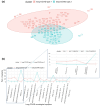Neurological long COVID in the outpatient clinic: Is it so long?
- PMID: 40115993
- PMCID: PMC11926444
- DOI: 10.1111/ene.16510
Neurological long COVID in the outpatient clinic: Is it so long?
Abstract
Background and purpose: Neurological involvement in long COVID (coronavirus disease 2019) is well known. In a previous study we identified two subtypes of neurological long COVID, one characterized by memory disturbances, psychological impairment, headache, anosmia and ageusia, and the other characterized by peripheral nervous system involvement, each of which present a different risk factor profile. In this study, we aimed to clarify the persistence of neurological long COVID symptoms with a significantly longer term follow-up.
Methods: We prospectively collected data from patients with prior COVID-19 infection who showed symptoms of neurological long COVID. We conducted a descriptive analysis to investigate the progression of neurological symptoms over time at 3-, 6-, 12-, and 18-month follow-ups. We performed a k-means clustering analysis on the temporal evolution of the symptoms at 6, 12, and 18 months. Finally, we assessed the difference between the recovery course of vaccinated and non-vaccinated patients by computing the cumulative recovery rate of symptoms in the two groups.
Results: The study confirmed the presence of two subtypes of neurological long COVID. Further, 50% of patients presented a complete resolution of symptoms at 18 months of follow-up, regardless of which subtype of neurological long COVID they had. Vaccination against SARS-Cov-2 appeared to imply a higher overall recovery rate for all neurological symptoms, although the statistical reliability of this finding is hampered by the limited sample size of the unvaccinated patients included in this study.
Conclusions: Neurological long COVID can undergo complete resolution after 18 months of follow-up in 50% of patients and vaccination can accelerate the recovery.
Keywords: COVID‐19; clustering; neurological long COVID; recovery rate; vaccination.
© 2025 The Author(s). European Journal of Neurology published by John Wiley & Sons Ltd on behalf of European Academy of Neurology.
Conflict of interest statement
The authors declare no conflicts of interest.
Figures




References
-
- Jain AK, Murty MN, Flynn PJ. Data clustering. ACM Comput Surv. 1999;31:264‐323. doi:10.1145/331499.331504 - DOI
MeSH terms
Grants and funding
LinkOut - more resources
Full Text Sources
Medical
Miscellaneous

